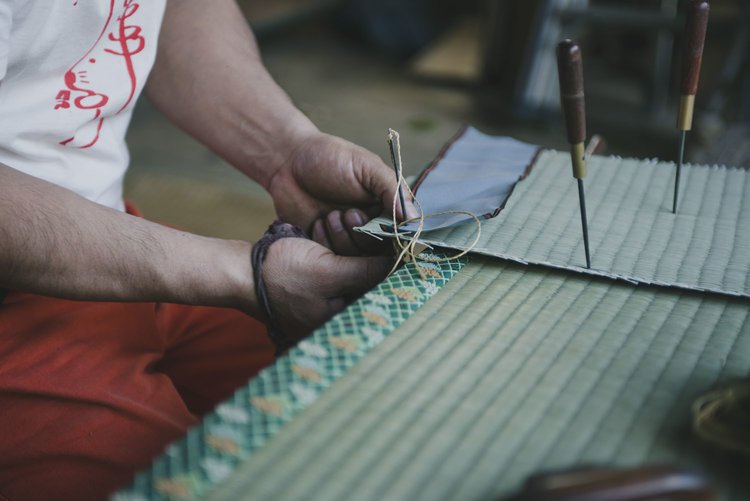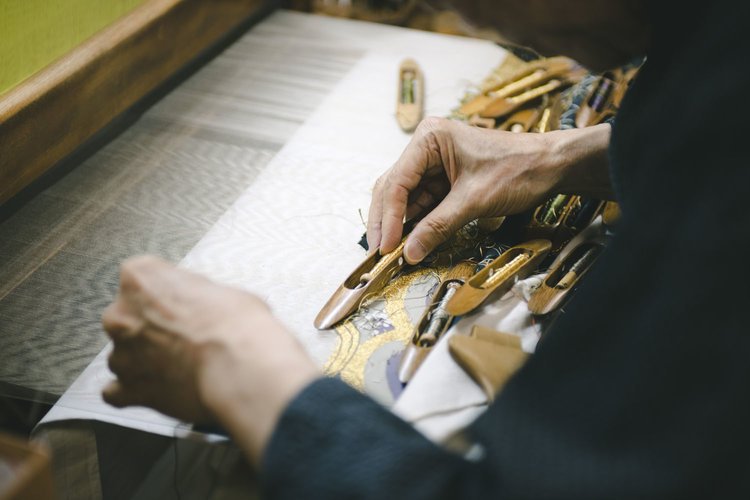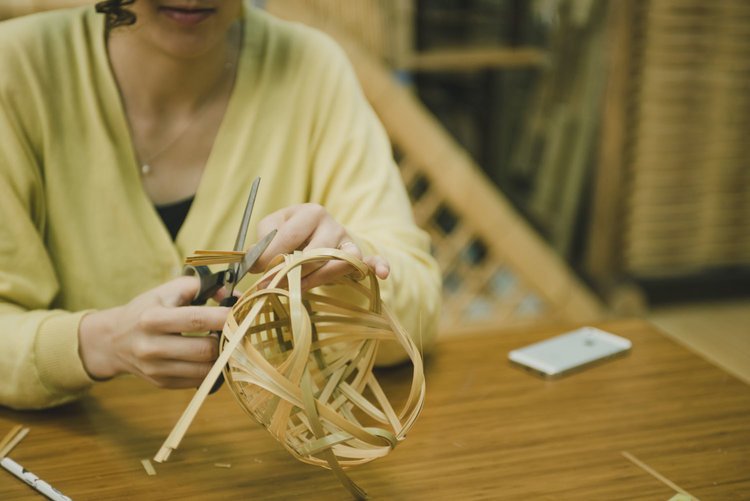Satoshi, Tatami Master
"Being open to reshaping the way tatami is used may ultimately alter its original purpose, but in doing so could safeguard the skills and story behind its existence."
In the undisturbed neighborhood of Yoshimi-machi, lies a small factory that has delivered tatami mats to the local community for the past 60 years. You can often find Satoshi in his corner of the factory, swiftly maneuvering the machines that carefully sew each side of a regular sized tatami mat. On a hot summer day, two large fans are left on to cool down Satoshi and his father while they work. Not limited to machines, Satoshi displays his dexterous side when making smaller tatami products by hand. Wrapping a tin plate around his elbow and palm for protection, he pierces through layers of igusa (rush plant) with a thickset needle. Satoshi possesses a grace in his movements; presumably acquired through years and years of training. Picking up the craft after his father, Satoshi has polished his trade in tatami making for nearly 3 decades. He exudes a gentle confidence, knowing that a part of his work involves keeping a dying tradition alive.
His father first began the trade in the 70s, keen on working and creating with his hands. At that time, Yoshimi-machi harbored a diverse clan of craftsmen within the architectural industry. Wall painters, carpenters, tile makers, and tatami makers were among the few who colored the local neighborhood. Satoshi shares, “I knew in the back of my head that I was going to take over the family business. It was something that I just knew.” 40 years later, the number of craftsmen has diminished, leaving but a few to preserve the tradition of their own craft. Satoshi reflects on this with a touch of defeat, “It’s really a change of culture. People want different lifestyles and that requires different housing arrangements.” With 20 years of experience, Satoshi’s tatami studio is now the only one standing in his neighborhood.
Tatami mats, unlike most traditional crafts in Japan, are a native born flooring material made out of igusa. Known as natural humidifiers, tatami work to keep summer cool and winter warm. Originally used by the aristocrats in Japan to indicate their social status, the practice of sleeping and sitting on tatami soon trickled down to a custom every family practiced. In the past 20 years, the tatami has seen its decline as younger people have begun to favor western-styled rooms in both public and private spaces. Following the decrease in demand, many craftsmen have been unable to find successors to carry on the tradition of tatami making. To combat its waning popularity, Satoshi has been experimenting with alternative means to use tatami. Early last year, he developed and designed a light tatami yoga mat that is portable. “I know yoga is popular nowadays so I decided to try and rearrange a version of the tatami mat that was once used a portable bed into a yoga mat,” explained Satoshi. Understanding the need to reinvent new ways of using tatami, Satoshi believes that being open minded to change is ultimately a key to preserving tradition.
Tatami has acted as a bridge to connect people to nature within an intimate and familiar context for centuries. It represents a certain symbiosis that needs to exist between people and nature in order to counterbalance our now heavily tech-centered lifestyle. Needless to say, tatami is one strand of Japan’s cultural basket that contains a multitude of intangible values. Providing a supportive environment where craftsmen like Satoshi can continue to practice is a road we have to turn into sooner than later.
Learn to weave a tatami mat with one of Japan's top tatami artisans
Traditions wax and wane: something that was applicable and abundant a decade ago may not be the case today. Revitalizing tatami is one that requires patience, dedication, and perseverance. Craftsmen like Satoshi bring the tenacity and flexibility in order for tatami to continue to survive today. Being open to reshaping the way tatami is used may ultimately alter its original purpose, but in doing so could safeguard the skills and story behind its existence.






